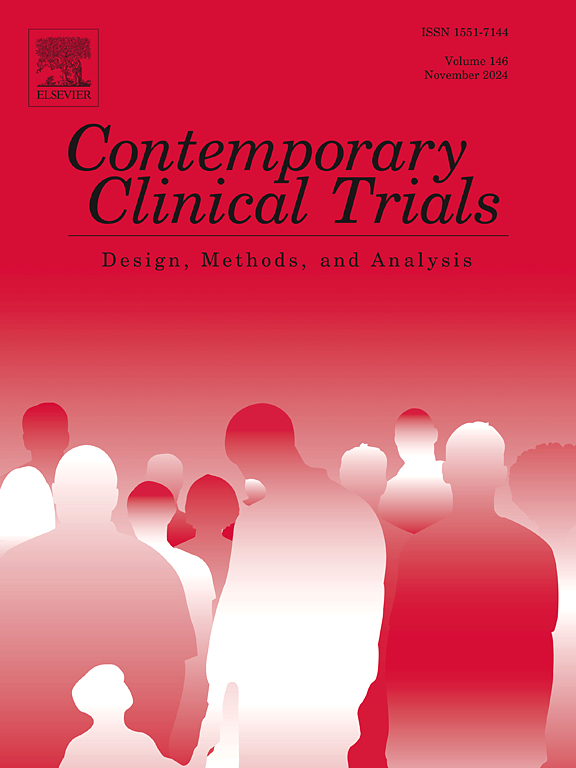Active symptom monitoring for premenopausal women with breast cancer initiating adjuvant endocrine therapy: Protocol for the SWOG S2010 randomized controlled efficacy trial
IF 2
3区 医学
Q3 MEDICINE, RESEARCH & EXPERIMENTAL
引用次数: 0
Abstract
Background
Premenopausal women with early stage, high risk hormone receptor positive breast cancer are at risk of early discontinuation of adjuvant endocrine therapy (ET), primarily because of toxicity, which can increase the risk of disease recurrence and death. We hypothesize that identification of bothersome symptoms between clinic visits, and automated notification of clinicians about symptoms, will result in improved persistence with ET.
Methods
Pre- and perimenopausal women planning to receive adjuvant treatment with tamoxifen or an aromatase inhibitor plus ovarian function suppression or ablation for treatment of breast cancer are eligible. A total of 540 participants will be enrolled and randomized 1:1 to patient education with or without Active Symptom Monitoring (ASM). The ASM intervention includes 6 symptom questions (hot flashes, sadness, anxiety, insomnia, vaginal dryness, joint pain) that will be completed via text, email, or telephone weekly for 24 weeks, then every 4 weeks for 48 weeks. All participants will complete a battery of questionnaires every 12 weeks to examine symptoms, beliefs about medicine, self-efficacy, and ET adherence. Optional blood draws will be collected at baseline and after 12, 48, and 72 weeks of therapy to examine estradiol and ET concentrations. The primary endpoint is time to nonpersistence with initially prescribed ET within the first 72 weeks, evaluated using Kaplan-Meier plots and multivariable Cox regression.
Conclusion
We expect early identification and management of ET-related toxicities to improve persistence with breast cancer therapy, breast cancer outcomes, and quality of life for premenopausal women at high risk of breast cancer recurrence.
Clinicaltrials.gov NCT05568472
对开始接受辅助内分泌治疗的绝经前乳腺癌妇女进行主动症状监测:SWOG S2010 随机对照疗效试验方案
背景患有早期、高风险激素受体阳性乳腺癌的绝经妇女面临着过早中断辅助内分泌治疗(ET)的风险,这主要是因为毒性会增加疾病复发和死亡的风险。我们假设,在就诊间隙发现令人烦恼的症状,并将症状自动通知临床医生,将提高 ET 的坚持率。方法 计划接受他莫昔芬或芳香化酶抑制剂加卵巢功能抑制或消融辅助治疗乳腺癌的绝经前和绝经期妇女均符合条件。共有 540 名参与者将被登记,并按 1:1 随机分配接受患者教育,同时接受或不接受主动症状监测 (ASM)。ASM 干预包括 6 个症状问题(潮热、悲伤、焦虑、失眠、阴道干涩、关节疼痛),这些问题将在 24 周内每周通过短信、电子邮件或电话完成,然后在 48 周内每 4 周完成一次。所有参与者将每 12 周完成一次问卷调查,以了解症状、对药物的看法、自我效能和坚持服药的情况。在基线期以及治疗 12、48 和 72 周后,将选择性地抽血检查雌二醇和 ET 浓度。主要终点是在最初开具的 72 周内不坚持使用 ET 的时间,使用 Kaplan-Meier 图和多变量 Cox 回归进行评估。结论:我们希望及早识别和处理 ET 相关毒性,以提高乳腺癌复发风险高的绝经前妇女的乳腺癌治疗坚持率、乳腺癌预后和生活质量。
本文章由计算机程序翻译,如有差异,请以英文原文为准。
求助全文
约1分钟内获得全文
求助全文
来源期刊
CiteScore
3.70
自引率
4.50%
发文量
281
审稿时长
44 days
期刊介绍:
Contemporary Clinical Trials is an international peer reviewed journal that publishes manuscripts pertaining to all aspects of clinical trials, including, but not limited to, design, conduct, analysis, regulation and ethics. Manuscripts submitted should appeal to a readership drawn from disciplines including medicine, biostatistics, epidemiology, computer science, management science, behavioural science, pharmaceutical science, and bioethics. Full-length papers and short communications not exceeding 1,500 words, as well as systemic reviews of clinical trials and methodologies will be published. Perspectives/commentaries on current issues and the impact of clinical trials on the practice of medicine and health policy are also welcome.

 求助内容:
求助内容: 应助结果提醒方式:
应助结果提醒方式:


